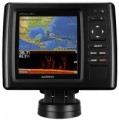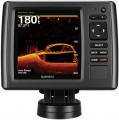Number of frequencies
The number of individual radiation frequencies that can be operated by a device with echo sounding function (see "Type").
The features of the frequencies themselves are described in detail below, but here we note that different models may provide different options for distributing frequencies over individual beams (see "Number of radiation beams"). So, in some devices, each beam has its own frequency, in others, individual emitters can be switched, choosing the best option depending on the characteristics of the situation. In general, more frequencies indicate greater versatility, but it significantly affects the price.
Radiation frequency
The frequency(s) of radiation at which the device with the echo sounder function is capable of operating (see "Type").
The higher the frequency, the better the resolution and noise immunity of the device, the better it is suitable for working at high speeds, but the range and coverage suffer. Low-frequency (up to 200 kHz) sensors, on the contrary, "reach" deep and cover a wide angle, but are sensitive to interference and do not work well with fine terrain details and small objects. Accordingly, the first option is considered optimal for shallow depths and high-precision topographic measurements, while the second option is for deep water bodies, as well as for searching for fish and other tasks that require wide coverage.
Models with several radiation beams (see “Number of radiation beams”) often provide different frequencies for individual beams, which allows you to combine the advantages of different options in one device and compensate for their disadvantages.
CHIRP Technology
Sonar support
for CHIRP technology.
The meaning of this technology is to use the echo sounder at the same time several frequencies. In other words, each pulse consists of several signals, each at its own frequency. According to the creators, this allows you to improve image quality, increase detail (including at great depth and high speed) and at the same time reduce the level of noise and other interference on the screen compared to single-frequency sonars. However, models with CHIRP are noticeably more expensive.
Bottom scan
Echosounder support for special
bottom scanning technologies.
"Viewing" the space under the bottom of the boat is a classic sonar mode and is supported by all models by definition. However, in normal mode, the sound beam propagates in the form of a cone, and the area of the bottom that falls under the beam has the shape of a circle. This degrades the accuracy and does not allow you to achieve a detailed image. Thus, many echo sounder manufacturers have developed special technologies to improve the performance of the instrument; Lowrance has DSI, Hummingbird has DI, Garmin has DownVü. The nuances of these technologies may differ, but the basic principle of operation is the same: the echo sounder beam narrows and goes not in a cone, but in a strip. Due to this, the resolution of the device is significantly increased; at shallow depths, such an echo sounder can “draw” even individual stalks of algae, making it possible to distinguish underwater thickets from schools of fish. Some models combine a narrow beam with a classic cone to further expand detection capabilities. However, such devices are expensive.
Waypoints
The maximum number of individual waypoints that can be stored in the chartplotter's memory.
Waypoints can be used as a base for routing, as reference marks on a map, such a point can be set as an immediate destination, etc.; specific use cases depend on the instrument model. But anyway, the more waypoints you can simultaneously enter into the chartplotter's memory, the more convenient it is to work with them and the less often you have to clean this memory to make new marks.
Number of points in the route
The maximum number of waypoints that can be set in one recorded route on the chartplotter.
In modern devices, this number can reach several tens of thousands. The abundance of points is important when laying complex routes, with many turns and curves that require maximum accuracy. Do not confuse this number with the number of individual waypoints (see "Number of waypoints"): in this case, only points included in a particular route and not used separately (there may be many times more) are meant.

